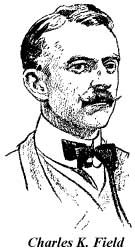|
This is the complete eight-page edition of Vol. XVII, No. 1, Sunset magazine’s May 1906 “New San Francisco Emergency Edition.”
The contents page lists the credit for the cover art, and the article “San Francisco” by Edward H. Harriman (1848 - 1909), president of the Southern Pacific Company, then owner and publisher of Sunset magazine. Harriman’s three-page article — probably ghost-written — outlines the “wonderful conditions” in San Francisco following the disaster, and how the city is to be rebuilt along modern, earthquake-safe and fireproof lines. The article also praises Mayor Eugene Schmitz, General Funston, Admiral Caspar Goodrich, and the California National Guard. Harriman’s article follows closely the narrative suggested in circulars to State chambers of commerce from James Horsburgh, Jr., General Passenger Agent for Southern Pacific. He was also in charge of Sunset magazine, then devoted to extolling the wonders of California, and was a promotion tool for the railroad. Horsburgh’s explicit instructions were to downplay the damage caused by the earthquake, and to emphasize the destruction of San Francisco by fire. Page 6 is titled “Greetings from the Publishers” and is a signed article by the editor Charles Sedgwick Aiken, who apologizes for the emergency edition, and explains how the magazine’s offices were destroyed by the Great Fire. He also promotes future articles for the June 1906 edition, including Charles Warren Stoddard’s “The Making of a Mission.” Page 8, the back cover, features a verse titled “The Choice,” by Charles K. Field, and line art by Maynard Dixon. There is a note from Sunset’s editor which accompanies this verse:
Charles Kellogg Field (1873-1948) , was a graduate of the Stanford class of 1895, and wrote Four-leaved Clover: being Stanford Rhymes,in 1896, under the pen name Carolus Ager. He also penned Stanford Stories, in 1900, with author Will Irwin. He wrote several Bohemian Grove plays performed during midsummer jinks between 1902 and 1918. He was very much a member of Bohemian Club and literary circles during the early part of the century. He entered broadcasting in his 60s, and was “Cheerio” on KGO-AM in the mid 1930s. He wrote “The Story of Cheerio” in 1936, and also authored, in 1940, “Cheerio’s Book of Days; Comfort, Cheer and Encouragement for Every Day in the Year,” a book of quotations for each day written under his radio name “Cheerio.” Field, however, is best known for writing this ditty following the 1906 earthquake:
A bronze tablet with this verse may, today, be found attached to the former A.P. Hotaling warehouse on Jackson Street, in the heart of the Barbary Coast.
|

